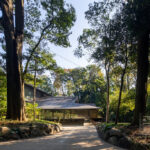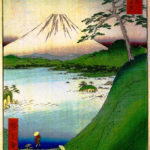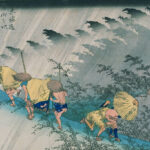
The three-story donjon of Hirosaki Castle dates from 1810.
TOM MIDWINTER PHOTO
With more than a few places, their very remoteness is part of the appeal. Even in an age of mass travel, such names as Zanzibar, Timbuktu and Kashgar still resonate with more than a little mystique because at one time they were symbols of such exotic seclusion. And though there are quite obviously differences in the geographical scale, the same essentially applies in Japan with a place such as Hirosaki.
At the northern tip of the country’s largest island of Honshu, Aomori Prefecture, in which Hirosaki is located, was for much of Japanese history pretty much the most remote spot in the land. This was particularly true for the period before the rise of Edo, as Tokyo was formerly known, in the seventeenth century, when Japan’s demographic center of gravity was located very much more to the west.

Close to the castle’s Otemon gate, the Former Hirosaki Public Library dates back to the Meiji period (1868–1912). TOM MIDWINTER PHOTO
An air of that once remoteness still hangs over Hirosaki today. Hirosaki is not the major urban center in Aomori, an honor that goes to the prefectural capital city of the same name to which Shinkansen bullet trains run. But by general consensus, Hirosaki is the most charming.
Located on the Tsugaru Plain, Hirosaki is one of those places that you find yourself liking the second you step off the bus. It wears the beguiling air of somewhere that is happily content to be out of step with the rest of the country and sets its clock to a more graceful age that puts enormous store on politeness. It is a place that seems to be agreeably impervious to the excessive whims and follies of fashion. It is a place where young Japanese still sport black hair.
One time of year, though, when sleepy Hirosaki does rouse itself comes when visitors descend in great numbers during the festival of Neputa. Similar to Aomori’s Nebuta Festival, Neputa is distinguished by huge illuminated, painted floats, which are paraded through the streets to the accompaniment of clamorous drums. Held in the first week of August, Neputa certainly has all the jolly character you would expect of a summer festival, though it does have its darker side. Swords and combat scenes are prominent in the figures depicted in the floats. Placid faces are few. The origins of the festival are obscure, but one story links it to when the Japanese were expanding into the country’s northernmost reaches around 1,300 years ago and ran into conflicts with the original inhabitants. Whatever you may think about this story, you don’t need to be a musicologist to recognize the stridently martial nature of the Neputa drumbeat.

The pub known as Yamauta is a good place to hear local music played on the Tsugaru-jamisen.
TOM MIDWINTER PHOTO
Local music of a different kind can be heard in the pub called Yamauta. This region is famed for the Tsugaru-jamisen, an instrument similar to the more familiar banjo-like shamisen, though with a thicker fingerboard and plucked with a bigger plectrum. Played in a distinctive percussive style, with the plectrum hammered onto the strings, the vigorous music of Tsugaru-jamisen is as far removed from the genteel plink-plonk of the normal shamisen as you could imagine. At Yamauta, all the serving staff double as virtuoso musicians, taking turns to perform on stage. Admittedly the bar is a bit of a tourist trap, with the audience consisting mostly out-of-towners, but the music is played with infectious gusto. You might enter Yamauta not knowing a thing about Tsugaru-jamisen, but it is hard to leave as anything but a budding aficionado.
Prominent in the stage backdrop at Yamauta are the two physical symbols of Hirosaki — Mount Iwaki and Hirosaki Castle. Mount Iwaki is the volcano that drapes itself across Hirosaki’s skyline — serene, powerful and not a little majestic. The mountain is often referred to as the Tsugaru Fuji — after the manner in which quite a number of provincial spots in Japan appropriate a little fame by adopting the name of a more renowned counterpart. When viewed from most angles, though, Mount Iwaki’s profile does make the Fuji comparison seem like the product of a rather wishful imagination. Built in 1611 (and again in 1810 after an earlier fire), Hirosaki Castle is one of Japan’s more pleasing fortresses. The donjon is a diminutive three-storied affair and engagingly seems far too small for the vast park that surrounds it. That park is famed as a spectacular spot for cherry blossoms when spring finally makes its way this far north. Then, the number of cherry trees in bloom is over 5,000; the number of visitors is overwhelming.

The Tsugaru region around Hirosaki is famed throughout Japan for its fine apples.
TOM MIDWINTER PHOTO
Other sights around town also have much to offer more by way of historical interest. Close to the castle’s Otemon gate are a couple of buildings dating back a century to the Meiji period (1868–1912), in that attractive East-meets-West style that has sadly disappeared from so much of Japan’s urban landscape. Rather older is the handsome 31-meter-high pagoda in red, white and green at the temple of Saisho-in, completed in 1667 and the northernmost five-storied pagoda in the land. Also dating back to the seventeenth century is the funerary temple of Chosho-ji, which was the final resting place for the lords of Tsugaru. Approached by a long, temple-lined avenue, Chosho-ji is a quietly impressive spot with its thick thatched roof built to withstand the heavy winter snows.
As might be supposed of a place at this northerly latitude, it is beset with winters of conspicuous harshness. And perhaps there is something about the bitter, unrelenting winters in this part of the country that draws out the natural warmth in the people. At a shop that didn’t look as if it had had a customer all day, I bought one of the apples for which Tsugaru is famed and in which it takes considerable pride. Despite the price being well under 100 yen, which would be unbelievably cheap for such a handsome, hefty apple in Tokyo, the shopkeeper still felt moved to offer me a discount. The people here are so spontaneously friendly that you find yourself wishing that you could take a couple of them home with you. Likable locals are probably not enough in themselves to propel anyone into making a journey. But if you find yourself with the chance of coming here again, they do make the decision to go that bit more attractive.
Tom Midwinter is a freelance writer and editor living in Tokyo.








